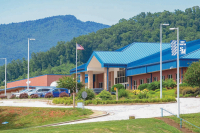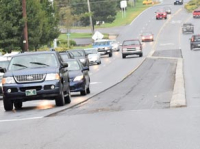Redistricting to grow mountain districts
In legislatures around the nation, it’s that time of decade again — time to break out the old redistricting maps and rehash the legislative lines.
Every 10 years, following the decennial census, lawmakers are constitutionally obliged to rearrange their districts so a roughly equal number of people are in each one, ensuring an representative Democracy of one person, one vote.
In North Carolina, the General Assembly is permanently comprised of 170 members: 50 senators and 120 representatives. Most every district will be finagled at least a little.
The state’s population grew by 18.5 percent, so the number of people in each districts must likewise grow. House districts, then, need 79,462 people. Senators now have to represent 190,710.
Since creating districts with such exact numbers would be hopelessly arduous, the rules allow for 5 percent more or less in every district.
For senators and representatives in the west, this means their districts will likely grow, pushing north and east in the pursuit of enough constituents.
Related Items
This whole series of scenarios is a picture of the larger, statewide trend: over the last decade, urban areas have blown up. Rural areas, not quite so much, according to the 2010 census.
So legislators in more rural regions on the state’s mountain and coastal bookends are going to see their already-sizable districts balloon in geographic scope, freeing up legislative seats for faster-growing urban areas.
On the whole, two governing principles drive the redistricting process: equal representation among districts and districts where the predominant factor isn’t race.
Beyond that, the state’s constitution asks that counties be kept together, though as Western North Carolina proves, that’s often impracticable.
Then there’s the added political layer, which is what produces gerrymandered districts, those that are outlandishly drawn to cater to one party or politician’s interest.
In the gerrymandering game, North Carolina isn’t quite a gold-medal winner. Maryland has a few districts that resemble nothing so much as a polygraph readout, while Florida boasts a congressional region or two that look like a dot-matrix printer gone awry on a map.
But political considerations have factored into the state’s districts, and they haven’t always taken the constitutional mandates into account, splitting counties either for necessity or political consideration.
One thing nearly everyone agrees on, however, is that the future of redistricting would be a more equitable landscape if politics were taken out of the process altogether.
That’s the intent of House Bill 824, co-sponsored by Rep. Ray Rapp, D-Mars Hill, which passed in the House earlier this month.
It calls for a non-partisan, staff-penned plan that’s based on district compactness, continuity and constitutional mandates. Legislators would then give the map an up-or-down vote.
“I think what’s important is they don’t take into account the current residence of sitting members. So you don’t get into ‘oh, that’s so-and-so’s district, we’ve got to carve that out so he stays or she stays in this district,’” said Rapp.
The plan would kick in with the 2020 census and is based on Iowa’s method, which has been operating there for four decades without a single court challenge. The same cannot be said for North Carolina’s procedures.
“I think what it’ll do is ensure fairness in the process,” said Rapp. “Every decade we’ve had court challenges to the redistricting plan in North Carolina. I think there’s just a time when you say, ‘let’s do it right.’ Just do it straight up, straight forward so it’s fair and let the chips fall where they may.”
Rapp found bi-partisan support for the measure in the House, and he’s hoping for the same in the Senate.
For his part, Sen. Jim Davis, R-Franklin, said he’s not against the idea.
“Some states do it that way and it seems to work pretty well,” said Davis. “Politicians are going to be really reluctant to give up that authority, but I think that has some merit.”
The legislature doesn’t yet have a final plan for the new districts, but committees have been meeting in both chambers to investigate the task, and the whole assembly is slated to start discussing it in mid-July, with recommendations due by the end of that month.
To split or not to split
Haywood County is a split county in both chambers represented by two different legislators. But now, there’s a move afoot to pull it back into a single district. Anyone putting pencil to paper to do the math, however, has realized it simply might not be possible.
This year, Haywood County’s Republican Party is lobbying for the county to be returned to one district, arguing that two house and two senate districts are confusing to voters and dilute the county’s legislative influence.
“It would be better if we were dealing with one legislator better than two,” said John Meinecke, chair of the Haywood County Republican Party. “The fact that we’ve been separated diminishes our political authority with the people in Raliegh. We’re the largest county west of Asheville, and yet it diminishes our political authority by having it divided the way it was.”
Local Democrats maintain the opposite, saying that four is always better than two, giving the county more clout and voice than surrounding counties.
“We are well-served — or have been in the past — by having four instead of two. We’ve had two senators and two representatives. I guess it just serves our county better,” countered Janie Benson, who heads up the Haywood Democrats.
Though they’d been asked to support a resolution in favor of joining the county, county commissioners declined to take a stance on the issue earlier this month.









